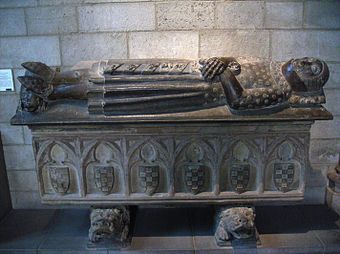- Ecclesiastical Confiscations of Mendizábal
-
 The sepulchre of Ermengol X (1274 - 1314), Count of Urgell and Viscount of Àger, sold in the 19th century to The Cloisters, New York, as a result of the Ecclesiastical Confiscations of Mendizábal
The sepulchre of Ermengol X (1274 - 1314), Count of Urgell and Viscount of Àger, sold in the 19th century to The Cloisters, New York, as a result of the Ecclesiastical Confiscations of Mendizábal
The Ecclesiastical Confiscations of Mendizabal, Spanish: Desamortización Eclesiástica de Mendizábal more often referred to simply as La Desamortización, encompasses a set of decrees from 1835-1837 that resulted in the expropriation, and privatization, of monastic properties in Spain.
The legislation was promulgated by Juan Álvarez Mendizábal, who was briefly prime minister under Queen Isabel II of Spain. The aims of the legislation were varied. Some of the impulses were fostered by anticlerical liberalism that was engaged in a civil war with Carlist and other reactionary forces. The government wished to use the land to encourage the enterprises of small-land owning bourgeoisie, since much of the land was underused by languishing monastic orders. The government, which did not compensate the church for the properties, saw this as a source of income. Finally, wealthy noble and other families took advantage of the legislation to increase their holdings.
Ultimately, the desamortización led to vacating most of the ancient monasteries in Spain, which had been in occupation for centuries. Only a few of the expropriations were reversed in subsequent decades.
See also
- Anticlericalism in Spain
References
- Joseph Harrison, An economic history of modern Spain, Page 26, Manchester University Press ND, 1978. ISBN 0719007046, 9780719007040
- Francisco Tomás y Valiente, El marco político de la desamortización en España. Ariel 1989 ISBN 8434407043
- Germán Rueda Hernánz, La desamortización en España: un balance, 1766-1924, Arco Libros. 1997. ISBN 9788476352700.
Categories:- Christian monasteries in Spain
- 19th century in Spain
- Political history of Spain
- Spanish history stubs
Wikimedia Foundation. 2010.
